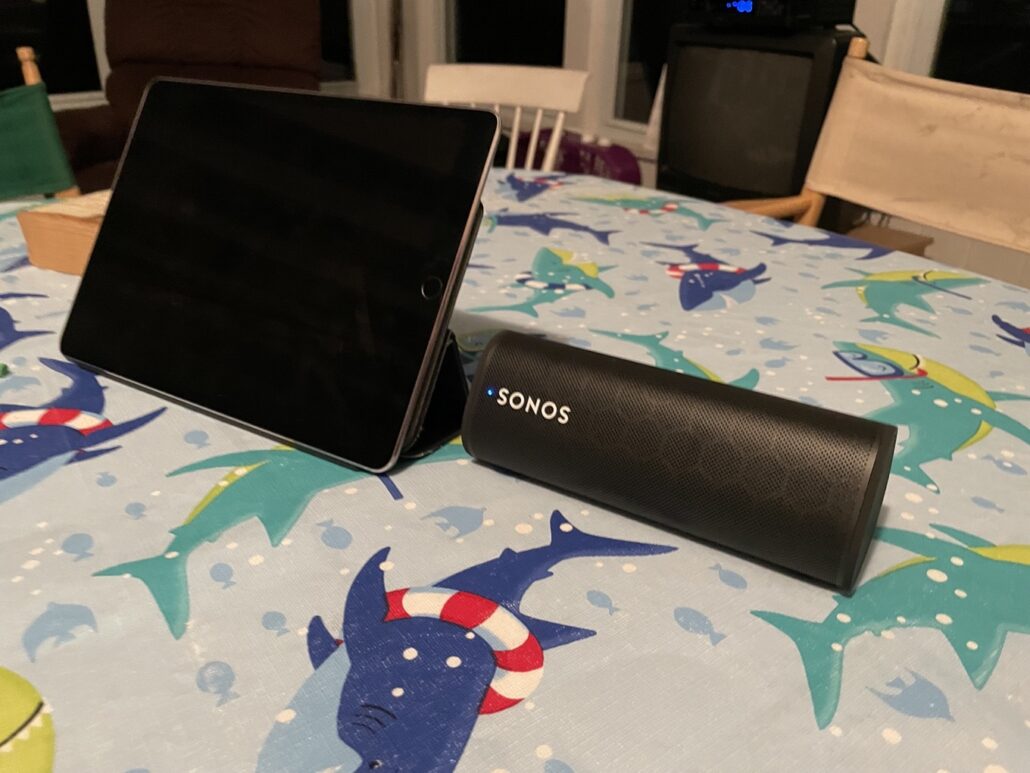
Review: Sonos Roam is a worthy travel companion

I picked up the Sonos Roam on a whim.
As we’ve gotten prepped to move to our new house, I’ve decided to switch up my TV audio setup from my old stereo receiver and bookshelf speakers to a soundbar, the Sonos Arc.1 When I made the purchase (on Massachusetts’s tax free weekend, and with a nice coupon), the discounted rate on the Roam made it a no-brainer to throw in. I figured it would make a solid “around the house” speaker that we could take outdoors, to a room with no other speakers, or even on a trip.
Conveniently enough, the Roam appeared just a couple days before my wife and I ventured off on vacation to a Wi-Fi-free undisclosed location, so I charged up the newly acquired Roam and threw it in my backpack.
This proved to be a solid decision.
When in Roam…

The Roam is pretty compact: at 6.61″ by 2.44″ by 2.36″, its rounded triangular body is about the size of a short, skinny water bottle. But that small chassis is packed with tech, attested to by its surprisingly heavy weight of .95 lbs.
Both end caps are rubberized, and one features playback controls: a play/pause button that also lets you skip tracks and go back with double and triple clicks, volume up/down, and a microphone mute. On one of the long edges you’ll find an on/off button also used for Bluetooth pairing, as well as a USB-C charging port. (That location, helpfully, ensures that the power button and charging port are always accessible, no matter the orientation of the Roam.)2
What makes the Sonos Roam attractive is its versatility. If you’ve got an existing Sonos setup, it’ll function like any other speaker in your setup; you can group it with other speakers and control playback via the Sonos app. Like most modern Sonos speakers, it also supports AirPlay 2, so once it’s configured, you can simply select it like any other AirPlay speaker from your iOS device or Mac.
However, if you take it out on the road, as I did, to some place where there’s no Wi-Fi network, Sonos has smartly made sure that the Roam maintains its utility via the inclusion of Bluetooth. That means you can take it anywhere you take your phone or other audio-playing device and still be able to jam to your tunes, listen to a podcast, or even watch some TV.
And indeed, we ended up using it for all of those things.
Roam-filling sound
The sound on the Roam is quite good. While it may not rival a full-size HomePod or a Sonos One, I’d say it gives the HomePod mini a run for its money: the highs are a little muddier, but it does pump out a decent amount of bass for its size.
We watched quite a few TV shows using the Roam, and it definitely outperformed the speakers on my 2017 10.5-inch iPad Pro, which are solid, if not earth-shattering. Podcasts and other spoken word content is crystal clear, and the volume levels can reach impressive levels, though we sometimes still had to crank it up a little higher when running a window fan nearby.
Bluetooth pairing was one of the few frustrations we encountered with the Roam. It works well enough with a single device, but switching between two phones and an iPad sometimes got confusing, leaving us to struggle with figuring out which device it was talking to. The reliance on a single button for both power and pairing can also be finicky, meaning you accidentally turn off the Roam when you’re trying to pair it or vice versa. I do, however, appreciate the inclusion of different colored LEDs embedded within the speaker grille to indicate status: blue for Bluetooth (blinking for pairing), white for powered on, orange for low charge, and so on.
Like other Sonos speakers that include microphones, the Roam supports both Google Assistant and Alexa, but I didn’t enable this feature in my testing mainly because I didn’t want to, but also because my experience with voice assistants via Sonos products has been lackluster. However, the Roam also uses its built-in microphone for automatic Trueplay tuning, so if you want the best sound for your space—including adjusting when you switch the speaker’s orientation—you’ll need to leave the mic on.
The Roam also includes one of Sonos’s most convenient features, letting you quickly group it with other Sonos speakers currently playing music by pressing and holding the Play/Pause button for a moment. Grouping them is handy if you want to share audio from AirPlay or Bluetooth to Sonos speakers that don’t support those features, such as my pair of Play:1s.
Sonos also included a new feature here called Sound Swap, which lets you in theory move music to and from other Sonos speakers. It’s cool when it works, but it comes with a handful of caveats: You can’t swap music from AirPlay, Bluetooth, or a TV, which means you generally need to start playback from the Sonos app. And it doesn’t work with older speakers, including my Play:1s, so I had to test it my Sonos/IKEA bookshelf speaker, at which point it did work pretty seamlessly. It’s a cool feature, but not a must-have, in my opinion.3
Where the buffalo Roam

The Roam, as mentioned, is designed for travel. Its battery life is solid: Sonos claims 10 hours of play time on a full charge. For us, with light-moderate usage, it lasted almost the entire week of our travel, with the caveat that I generally turned it all the way off (holding down the power button for five seconds) when it wasn’t going to be in use for a while, rather than simply putting it into the sleep mode triggered by pressing the power button. (For another data point, the Wirecutter’s examination of the Roam got only about six hours of playback time. Your mileage, as always, may vary.)
That said, charging the battery is not exactly a speedy endeavor. Sonos says it takes an hour to go from zero to 50 percent via the included USB-C to USB-A cable (there’s no power plug in the box); expect to wait a couple hours longer to get to full—ideally, I’d leave it plugged in overnight. The good news is that you can keep playing as it’s charging, though I’m guessing it will take a bit longer to charge in that case. It also supports standard wireless Qi charging, though that’ll take about twice as long as USB. (Sonos is also selling a magnetic charging base for $50 which is cool, but definitely a bit steep.)
Since you’re intended to carry it about with you, the Roam is also designed for durability: its rubber end caps are supposed to make it more resilient to drops—I didn’t put that feature to any sort of substantive test—and it’s resistant to both dust and water, with an IP67 rating that should make it solidly splash-proof, in addition to surviving submersion into a meter of water for up to 30 minutes.
Given those specs, I can understand why Sonos didn’t feel the need to include a carrying case: the idea is that this isn’t a speaker that you need to baby. That said, I did use the included paper/cloth packaging before I put it in my bag; it’s clearly not intended for protective or repeated usage, but at least it made me feel a bit better. (Amazon, unsurprisingly, already lists tons of third-party carrying cases, if you’re so inclined.)
Final Roam-marks4
At $169, the Sonos Roam is hardly the cheapest portable speaker you can get—$20 Bluetooth models abound, though you all too often get what you pay for. Neither, however, is it the most expensive option. All but the budget pick in the Wirecutter’s guide to Bluetooth speakers have list prices in that vicinity, if not more expensive, and there are discounts to be had, especially if you’re an existing Sonos customer.
For those who have already immersed themselves in the Sonos ecosystem, the Roam feels like a no-brainer. Its integration is strong, and the ability to carry it with you onto a patio, porch, or stoop is great. Expect a little more futzing if you take it with you some place without a Wi-Fi network, but once you’ve got it paired, the experience is still positive.
If you’re not a Sonos user, the Roam is certainly a tougher sell, since many of the features that owners of other Sonos speakers will appreciate won’t really be of benefit to you. It’s still a solid Bluetooth/AirPlay speaker, but there are other options in the market that may prove more affordable for much the same performance.
Overall, however, I’m quite pleased with the Roam. I’ve used other Bluetooth speakers throughout the years, and while they’ve all been fine, I appreciate that Sonos’s feels like a solid device built to last, and its wide variety of features should mean that it continues its utility for a while to come.
- More on which, probably, once I’ve gotten a chance to set it up. ↩
- It’s a lovely bit of serendipity that Sonos’s name happens to be symmetrical in such a way that it reads correctly in both the “correct” horizontal position and “upside down”. ↩
- Although it did make me wish Apple’s own Handoff feature with the HomePod worked better. ↩
- If only I had taken the speaker to a beach near where I got my secondary education I could have titled this section “Roamy and my shell’s high school reunion.” ↩






